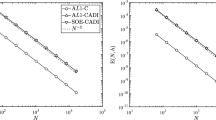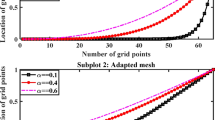Abstract
In Li et al. (J Sci Comput 76(3):1905–1937, 2018), a temporal second-order mixed finite element scheme has been proposed for the thin film epitaxial growth model without slope selection. Using the super-convergence theory in a regular rectangular mesh, the authors of Li et al. (2018) proved an optimal \(O(h^{q+1}+\tau ^2)\) convergence. However, in a quasi-uniform triangulation mesh setting, only a sub-optimal convergence rate \(O(h^q+\tau ^2)\) is proved, while numerical results indicated an optimal \(O(h^{q+1}+\tau ^2)\) convergence when the exact solution has \(H^{q+1}\) regularity in space. Here h and \(\tau \) are the discretization sizes in space and time, respectively, and \(q\ge 1\) is the degree of the polynomial in the spatial discretization. In this paper, we provide a theoretical proof of the optimal convergence rate. The main difficulty lies in how to treat a nonlinear term \(\frac{\nabla u}{1+|\nabla u|^2}\). We solve this by using a discrete Laplacian operator \(-\varDelta _h\) and some uncommon techniques in the analysis. Numerical results are also presented to demonstrate the \((q+1)\)-order convergence of the spatial approximation.
Similar content being viewed by others
References
Adams, R.A., Fournier, J.J.F.: Sobolev Spaces, 2nd edn. Academic Press, Singapore (2003)
Brenner, S., Scott, R.: The Mathematical Theory of Finite Element Methods, 3rd edn. Springer, New York, NY (2007)
Chen, W., Conde, S., Wang, C., Wang, X., Wise, S.: A linear energy stable scheme for a thin film model without slope selection. J. Sci. Comput. 52, 546–562 (2012)
Chen, W., Wang, C., Wang, X., Wise, S.: A linear iteration algorithm for energy stable second order scheme for a thin film model without slope selection. J. Sci. Comput. 59, 574–601 (2014)
Chen, W., Wang, X., Yan, Y., Zhang, Z.: A second order BDF numerical scheme with variable steps for the Cahn–Hilliard equation. SIAM J. Numer. Anal. 57(1), 495–525 (2019)
Chen, W., Wang, Y.: A mixed finite element method for thin film epitaxy. Numer. Math. 122, 771–793 (2012)
Cheng, K., Feng, W., Wang, C., Wise, S.M.: An energy stable fourth order finite difference scheme for the Cahn–Hilliard equation. J. Comput. Appl. Math. (2018). https://doi.org/10.1016/j.cam.2018.05.039 (forthcoming)
Cheng, K., Wang, C., Wise, S.M.: An energy stable Fourier pseudo-spectral numerical scheme for the square phase field crystal equation. Commun. Comput. Phys. (2019). http://www.math.umassd.edu/~cwang/Cheng19a.pdf (accepted)
Eyre, D.J.: Unconditionally gradient stable time marching the Cahn–Hilliard equation. MRS Proc. 529, 39–46 (1998)
Feng, W., Wang, C., Wise, S.M., Zhang, Z.: A second-order energy stable backward differentiation formula method for the epitaxial thin film equation with slope selection. Numer. Methods Partial Differ. Equ. 34(6), 1975–2007 (2018)
Girault, V., Raviart, P.A.: Finite Element Methods for Navier–Stokes Equations: Theory and Algorithms. Springer-Verlag, Berlin (1986)
Golubović, L.: Interfacial coarsening in epitaxial growth models without slope selection. Phys. Rev. Lett. 78, 90–93 (1997)
Heywood, J.G., Rannacher, R.: Finite element approximation of the nonstationary Navier–Stokes problem. I. Regularity of solutions and second-order error estimates for spatial discretization. SIAM J. Numer. Anal. 19(2), 275–311 (1982)
Hunt, A.W., Orme, C., Williams, D.R.M., Orr, B.G., Sander, L.M.: Instabilities in MBE growth. EPL 27(8), 611–616 (1994)
Ju, L., Li, X., Qiao, Z., Zhang, H.: Energy stability and error estimates of exponential time differencing schemes for the epitaxial growth model without slope selection. Math. Comput. 87(312), 1859–1885 (2018)
Kohn, R.V.: Energy-driven pattern formation. Int. Congr. Math. 1, 359–383 (2007)
Kohn, R.V., Yan, X.: Upper bound on the coarsening rate for an epitaxial growth model. Commun. Pure Appl. Math. 56, 1549–1564 (2003)
Li, B.: High-order surface relaxation versus the Ehrlich–Schwoebel effect. Nonlinearity 19(11), 2581–2603 (2006)
Li, B., Liu, J.: Thin film epitaxy with or without slope selection. Eur. J. Appl. Math. 14, 713–743 (2003)
Li, B., Liu, J.G.: Epitaxial growth without slope selection: energetics, coarsening, and dynamic scaling. J. Nonlinear Sci. 14, 429–451 (2004)
Li, D., Qiao, Z., Tang, T.: Characterizing the stabilization size for semi-implicit Fourier-spectral method to phase field equations. SIAM J. Numer. Anal. 54, 1653–1681 (2016)
Li, J.: Full-order convergence of a mixed finite element method for fourth-order elliptic equations. J. Math. Anal. Appl. 230, 329–349 (1999)
Li, W., Chen, W., Wang, C., Yan, Y., He, R.: A second order energy stable linear scheme for a thin film model without slope selection. J. Sci. Comput. 76(3), 1905–1937 (2018)
Li, X., Qiao, Z., Zhang, H.: Convergence of a fast explicit operator splitting method for the epitaxial growth model with slope selection. SIAM J. Numer. Anal. 55, 265–285 (2017)
Politi, P., Torcini, A.: Coarsening in surface growth models without slope selection. J. Phys. A Math. Theor. 33(8), 77–82 (2000)
Qiao, Z., Sun, Z., Zhang, Z.: The stability and convergence of two linearized finite difference schemes for the nonlinear epitaxial growth model. Numer. Methods Partial Differ. Equ. 28, 1893–1915 (2012)
Qiao, Z., Sun, Z., Zhang, Z.: Stability and convergence of second-order schemes for the nonlinear epitaxial growth model without slope selection. Math. Comput. 84, 653–674 (2015)
Qiao, Z., Wang, C., Wise, S., Zhang, Z.: Error analysis of a finite difference scheme for the epitaxial thin film growth model with slope selection with an improved convergence constant. Int. J. Numer. Anal. Model. 14, 283–305 (2017)
Qiao, Z., Zhang, Z., Tang, T.: An adaptive time-stepping strategy for the molecular beam epitaxy models. SIAM J. Sci. Comput. 33, 1395–1414 (2012)
Rost, M., Krug, J.: Coarsening of surface structures in unstable epitaxial growth. Phys. Rev. E 55, 3952–3957 (1997)
Shen, J., Wang, C., Wang, X., Wise, S.: Second-order convex splitting schemes for gradient flows with Ehrlich–Schwoebel type energy: application to thin film epitaxy. SIAM J. Numer. Anal. 50, 105–125 (2012)
Siegert, M., Plischke, M.: Slope selection and coarsening in molecular beam epitaxy. Phys. Rev. Lett. 73, 1517–1520 (1994)
Thomée, V.: Galerkin Finite Element Methods for Parabolic Problems, vol. 1054. Springer, Berlin (1984)
Wang, C., Wang, X., Wise, S.: Unconditionally stable schemes for equations of thin film epitaxy. Discrete Contin. Dyn. Syst. 28, 405–423 (2010)
Xu, C., Tang, T.: Stability analysis of large time-stepping methods for epitaxial growth models. SIAM J. Numer. Anal. 44(4), 1759–1779 (2006)
Yan, N.: Superconvergence Analysis and a Posteriori Error Estimation in Finite Element Methods. Science Press, Beijing (2008)
Yan, Y., Chen, W., Wang, C., Wise, S.M.: A second-order energy stable BDF numerical scheme for the Cahn–Hilliard equation. Commun. Comput. Phys. 23(2), 572–602 (2018)
Yan, Y., Li, W., Chen, W., Wang, Y.: Optimal convergence analysis of a mixed finite element method for fourth-order elliptic problems. Commun. Comput. Phys. 24(2), 510–530 (2018)
Yang, X., Zhao, J., Wang, Q.: Numerical approximations for the molecular beam epitaxial growth model based on the invariant energy quadratization method. J. Comput. Phys. 333, 104–127 (2017)
Acknowledgements
This work is supported in part by the Grants NSFC 11671098, 11331004, 91630309, a 111 Project B08018 (W. Chen), the Grants NSFC 11671210, 91630201 (Y. Wang), and the Grant 2017110715 (Y. Yan). Y. Yan also thanks the support by Institute of Scientific Computation and Financial Data Analysis, Shanghai University of Finance and Economics.
Author information
Authors and Affiliations
Corresponding author
Additional information
Publisher's Note
Springer Nature remains neutral with regard to jurisdictional claims in published maps and institutional affiliations.
Rights and permissions
About this article
Cite this article
Chen, W., Zhang, Y., Li, W. et al. Optimal Convergence Analysis of a Second Order Scheme for a Thin Film Model Without Slope Selection. J Sci Comput 80, 1716–1730 (2019). https://doi.org/10.1007/s10915-019-00999-y
Received:
Revised:
Accepted:
Published:
Issue Date:
DOI: https://doi.org/10.1007/s10915-019-00999-y




